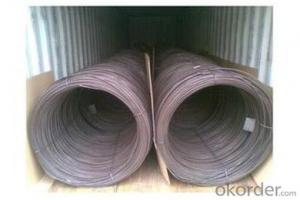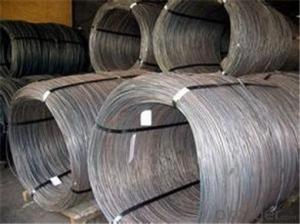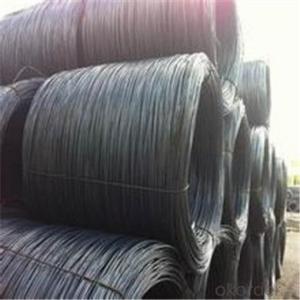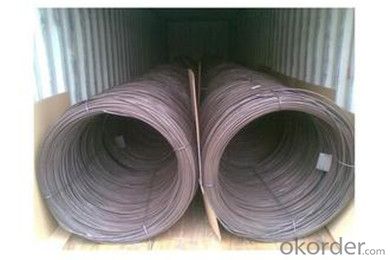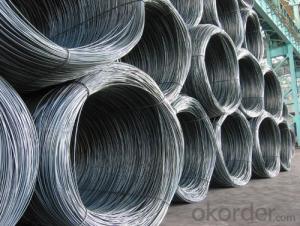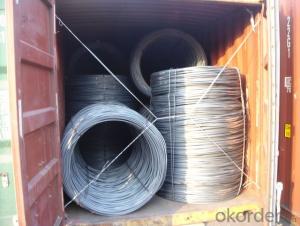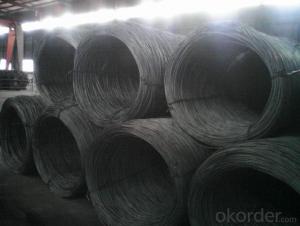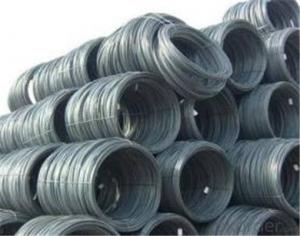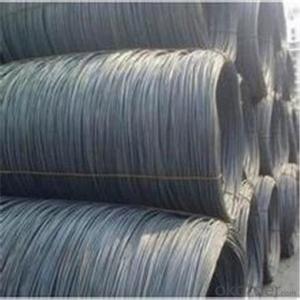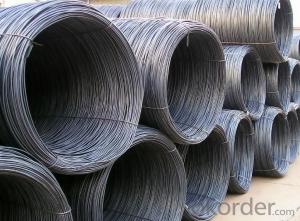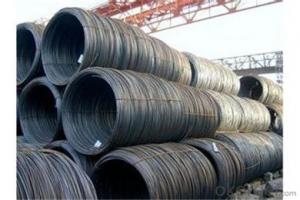SAE1008Gr Steel Wire rod 5.5mm with Best Quality in China
- Loading Port:
- Shanghai
- Payment Terms:
- TT OR LC
- Min Order Qty:
- 99 m.t.
- Supply Capability:
- 45555555 m.t./month
OKorder Service Pledge
OKorder Financial Service
You Might Also Like
Specification
Description of wire Rod:
wire rod:
Grade:SAE1006B/SAE1008B/SAE1018B
Size:5.5/6.5/7/8/9/10/11/12mm
Festures of wire Rod:
1. Drawn wire specialist, your wire rod solution
2. ISO9001 Certified Mill &SGS
3. Feature: machinability, high hardness, toughness, corrosion resistant
4. Clear and smooth surface, high precision and Tolerance control: ± 0.01
5. Customized service for your special requirement
6. Reasonable and more competitive mill price for you.
Specifications of wire Rod:
Product | steel wire rod |
Standard | AISI, ASTM, BS, DIN, GB, JIS |
Material/steel grade | Q195-Q235,SAE1006, SAE1008, SAE1010, SAE1018, SAE1020 or according to customers requirements |
Wire Gauge | 5.5-12mm |
Coil weight | 1.8-2.1mts |
MOQ | 25MT |
Delivery Time | 15-30 days after receipt of L/C or deposit by T/T |
Packing | In coil and load in container, if large quantity, by bulk vessel; Can be packed as customers' special requirements |
Payment terms | 1).100% irrevocable L/C at sight. |
Application | widely used in machinery parts, manufacturing industry, electronics industry, metal tools and others |
FAQ: 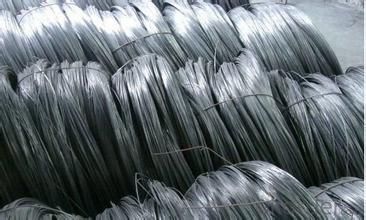 Images of wire Rod:
Images of wire Rod:
1. What is your package?
Packing situation: standard seaworthy packing or as customer required.
2. How long is the lead time?
Delivery time: 45 days after order confirmed.
3. What payment term do you accept?
Payment: T/T or L/C at sight.
- Q: What are the common standards and certifications for steel wire rod?
- Steel wire rod must adhere to various standards and certifications to ensure its quality and compliance with industry regulations. Some widely recognized ones include: 1. ASTM International Standards: Commonly used for steel wire rod are ASTM A510 and ASTM A853. These standards outline the necessary requirements for carbon steel wire rods used in various applications, such as wire product manufacturing, nail production, and fencing. 2. ISO Certification: ISO 9001 is a well-known quality management system standard that guarantees consistent quality and customer satisfaction. Many steel wire rod manufacturers obtain ISO 9001 certification, indicating their commitment to rigorous quality control processes. 3. European Standards (EN): EN 10016-2 is a standard specifically applicable to wire rod manufactured and used within the European Union. It specifies the technical delivery conditions for non-alloy steel wire rod used for general purposes. 4. American Petroleum Institute (API) Certification: API Spec 5L is a certification specifically relevant to steel wire rod used in the oil and gas industry. This certification ensures that the wire rod meets the necessary requirements for use in pipelines and related applications. 5. International Electrotechnical Commission (IEC) Standards: IEC 60949 is a standard that specifies the requirements for copper or aluminum wire rod used in electrical purposes. Although not specifically for steel wire rod, the electrical industry follows IEC standards to ensure safety and performance. It is crucial to note that different applications may have specific requirements, and manufacturers often comply with additional industry-specific certifications or customer-specific standards. These certifications and standards are vital in maintaining consistent quality, safety, and performance of steel wire rod in various industries.
- Q: How are steel wire rods used in the manufacturing of bicycle spokes?
- Bicycle spokes heavily rely on steel wire rods, which are pivotal in their production. Typically, these wire rods are crafted from top-notch steel and undergo a series of processes to attain the desired strength and flexibility required for spokes. To commence, meticulous selection and inspection of the steel wire rods are carried out to identify any imperfections or defects. Once the quality check is completed, the rods undergo a thorough cleaning and straightening process to ensure they are devoid of any debris or bends that may jeopardize their structural integrity. Subsequently, the wire rods are precisely cut into lengths that are determined based on the specific measurements required for the bicycle spokes. These measurements are typically based on the size and design of the bicycle wheel. Following the cutting process, the wire rods undergo a crucial procedure called swaging, wherein the diameter of the rod's ends is reduced. This swaging process is of utmost importance as it facilitates the creation of a tapered shape that allows for effortless insertion into the hub and rim of the bicycle wheel. Upon completion of the swaging process, the wire rods are then threaded at one end. This threading is indispensable as it enables the attachment of the spoke nipple, which connects the spoke to the wheel rim. Lastly, the wire rods are treated with a protective coating, such as zinc plating, to enhance their corrosion resistance and ensure their durability. This coating not only increases the longevity of the spokes but also adds an aesthetic appeal. In conclusion, steel wire rods play an indispensable role in the manufacturing of bicycle spokes. Through the selection, cleaning, straightening, cutting, swaging, threading, and coating processes, spokes that are strong, flexible, and corrosion-resistant are created. These spokes are a vital component in ensuring the structural integrity and smooth operation of bicycle wheels.
- Q: What are the different types of steel wire rod coatings used for increased strength?
- To enhance the strength of steel wire rods, various coatings are commonly applied. These coatings aim to improve the mechanical properties and overall performance of the wire rod. One frequently used coating for increased strength is zinc coating, also known as galvanizing. This process involves immersing the wire rod in molten zinc, resulting in a protective layer that offers excellent corrosion resistance. Furthermore, the zinc coating acts as a barrier, preventing direct contact with corrosive substances and thereby increasing the wire rod's strength and durability. Another coating option for increased strength is polymer coating. This protective layer is applied to the wire rod through methods like extrusion or electrostatic spraying. It provides resistance against abrasion, impact, and corrosion while also enhancing flexibility and fatigue resistance, ultimately improving the wire rod's overall strength. Epoxy coatings are also commonly used to increase strength. These coatings, composed of a mixture of resin and hardener, are applied to the wire rod's surface through electrostatic deposition. They offer exceptional adhesion and chemical resistance, making the wire rod stronger and more corrosion-resistant. Additionally, ceramic coatings are utilized to enhance the strength of steel wire rods. These coatings are typically applied through thermal spraying techniques, where a ceramic material is heated and propelled onto the wire rod's surface. Ceramic coatings provide exceptional hardness, wear resistance, and high-temperature resistance, making the wire rod more robust and suitable for demanding applications. In conclusion, zinc coating, polymer coating, epoxy coating, and ceramic coating are among the various types of steel wire rod coatings used to increase strength. Each of these coatings offers distinct advantages in terms of corrosion resistance, flexibility, adhesion, and wear resistance, ultimately enhancing the wire rod's strength and durability.
- Q: What are the main factors influencing the choice of steel wire rod order payment terms options?
- The main factors influencing the choice of steel wire rod order payment terms options include the financial stability and creditworthiness of the buyer, the volume and frequency of the orders, the competitive landscape within the industry, the level of trust between the buyer and the seller, and the prevailing market conditions.
- Q: What are the safety requirements for steel wire rod used in mining wire ropes?
- The safety requirements for steel wire rod used in mining wire ropes are crucial to ensure the safe and reliable operation of mining equipment. These requirements are necessary to prevent accidents, injuries, and fatalities that may occur due to the failure of wire ropes. 1. Material Composition: The steel wire rod used in mining wire ropes must be manufactured from high-quality steel with specific properties to withstand the demanding conditions in mining operations. It should have a high tensile strength, excellent fatigue resistance, and good ductility. 2. Strength and Durability: The wire rod should meet specific strength requirements to ensure it can handle the load and stress associated with mining activities. It must be able to withstand heavy loads, sudden impacts, and repetitive bending and flexing without showing signs of fatigue or failure. 3. Surface Quality: The surface of the steel wire rod should be smooth and free from any cracks, deformations, or defects that could compromise the integrity of the wire rope. A rough or uneven surface can lead to increased friction, wear, and potential failures during operation. 4. Dimensional Accuracy: The wire rod should adhere to precise dimensional tolerances to ensure compatibility with other components of the wire rope system. Accurate dimensions are necessary for proper assembly, fitting, and functionality of the wire rope. 5. Heat Treatment: Proper heat treatment processes, such as annealing or quenching, should be applied to the wire rod to enhance its mechanical properties. Heat treatment can improve the strength, hardness, and resistance to wear and corrosion, making the wire rope more reliable and durable. 6. Quality Control: Rigorous quality control measures should be implemented during the manufacturing process to ensure the wire rod meets the specified safety requirements. Regular inspections, testing, and certifications should be carried out to verify the material's compliance with industry standards and regulations. 7. Documentation and Traceability: It is essential to maintain accurate documentation and traceability records for the steel wire rod used in mining wire ropes. This allows for proper tracking of the material's origin, manufacturing process, and quality control procedures, ensuring accountability and facilitating any necessary investigations or recalls. Adhering to these safety requirements for steel wire rod used in mining wire ropes is crucial to maintaining the integrity and reliability of the equipment. Regular inspection and maintenance of the wire ropes should also be conducted to ensure their continued safe operation.
- Q: What are the main factors affecting the market research of steel wire rod?
- The main factors affecting the market research of steel wire rod include supply and demand dynamics, price fluctuations, technological advancements, industry regulations, and the impact of global economic conditions. Additionally, factors like raw material availability, competition from alternative materials, and changing consumer preferences also play a significant role in shaping the market research of steel wire rod.
- Q: How does steel wire rod compare to other materials, such as aluminum or copper?
- Steel wire rod is a superior material compared to aluminum or copper in terms of strength and durability. Steel has a higher tensile strength, making it suitable for applications requiring high strength and load-bearing capacity. Additionally, steel wire rod exhibits excellent resistance to corrosion and can withstand harsh environmental conditions better than aluminum or copper. While aluminum and copper have their own advantages such as being lighter and better conductors of electricity respectively, steel wire rod is generally preferred in industries where strength and longevity are paramount.
- Q: How are steel wire rods stored to prevent corrosion?
- Steel wire rods are typically stored in a way that minimizes exposure to moisture and air, which are the primary causes of corrosion. To prevent corrosion, the rods are usually stored in a dry and well-ventilated area, away from direct contact with the ground and any potential sources of moisture such as water pipes or damp walls. They are often stored on pallets or racks, allowing for proper airflow and preventing contact with any surface that may contain water or excessive humidity. Additionally, steel wire rods are often coated with a protective layer, such as oil or a rust preventive compound, to further safeguard against corrosion during storage. Regular inspections and maintenance are also crucial to ensure that the storage conditions remain optimal and any signs of corrosion are promptly addressed.
- Q: How is steel wire rod used in the manufacturing of wire for surgical sutures?
- Steel wire rod is used in the manufacturing of wire for surgical sutures by being drawn down to the desired diameter and then coated with a biocompatible material such as chromium or silicone. This process ensures that the wire is smooth, sterile, and strong enough to be used in sutures for various medical procedures.
- Q: How is steel wire rod used in the manufacturing of wire for bicycle chains?
- Steel wire rod is used in the manufacturing of wire for bicycle chains as it serves as the raw material for creating the chain links. The wire rod is first drawn through a series of dies to reduce its diameter and increase its strength. This process helps to form the individual chain links with the desired size and shape. The hardened and tempered steel wire rod ensures that the bicycle chain is durable, strong, and capable of withstanding the stress and tension it experiences during use.
Send your message to us
SAE1008Gr Steel Wire rod 5.5mm with Best Quality in China
- Loading Port:
- Shanghai
- Payment Terms:
- TT OR LC
- Min Order Qty:
- 99 m.t.
- Supply Capability:
- 45555555 m.t./month
OKorder Service Pledge
OKorder Financial Service
Similar products
Hot products
Hot Searches
Related keywords
